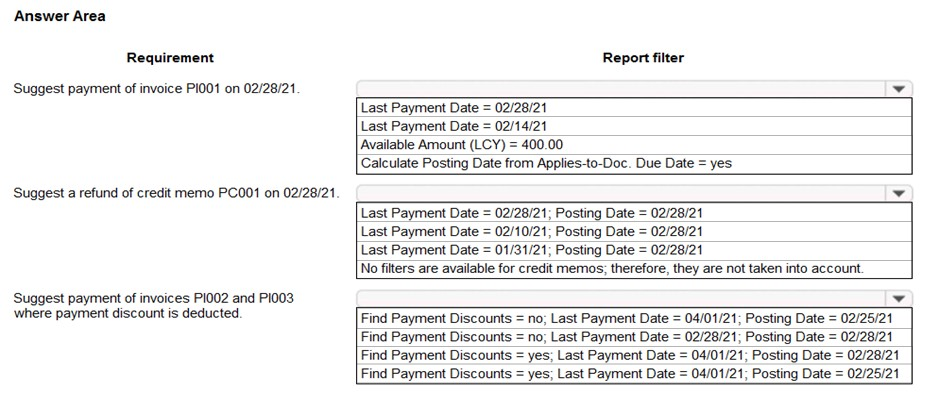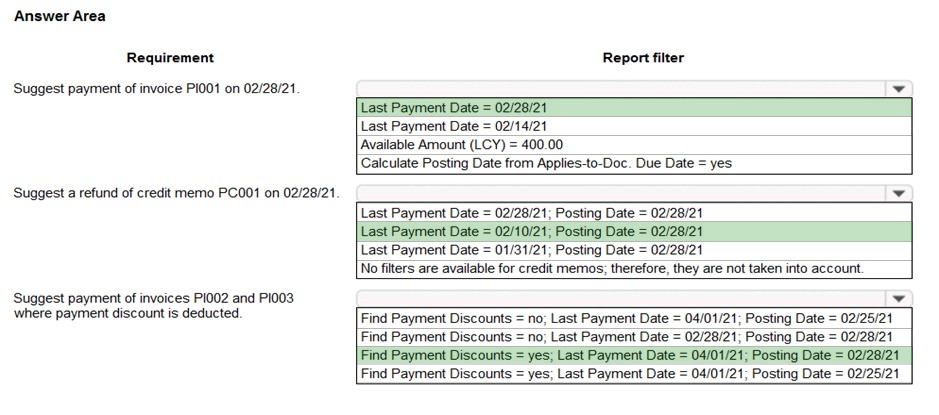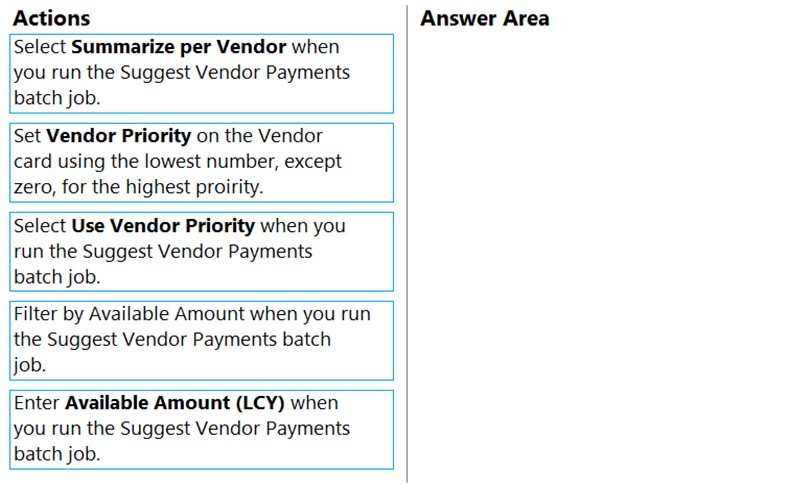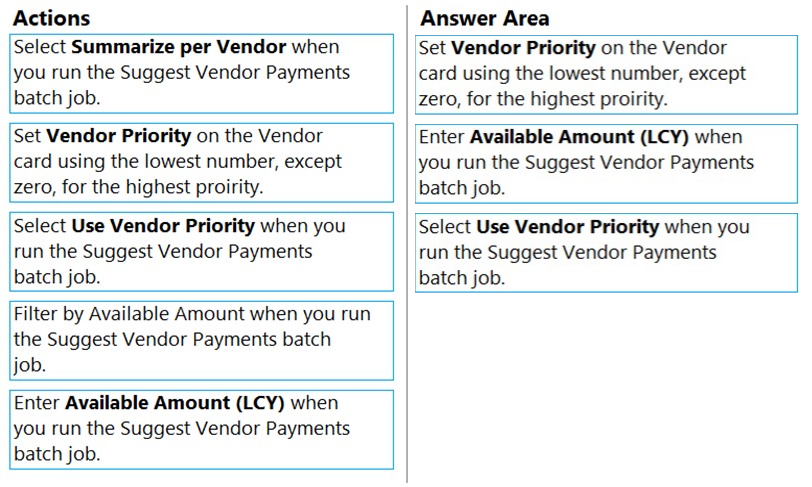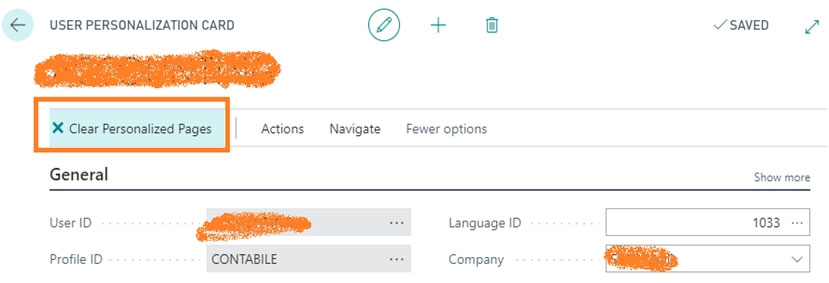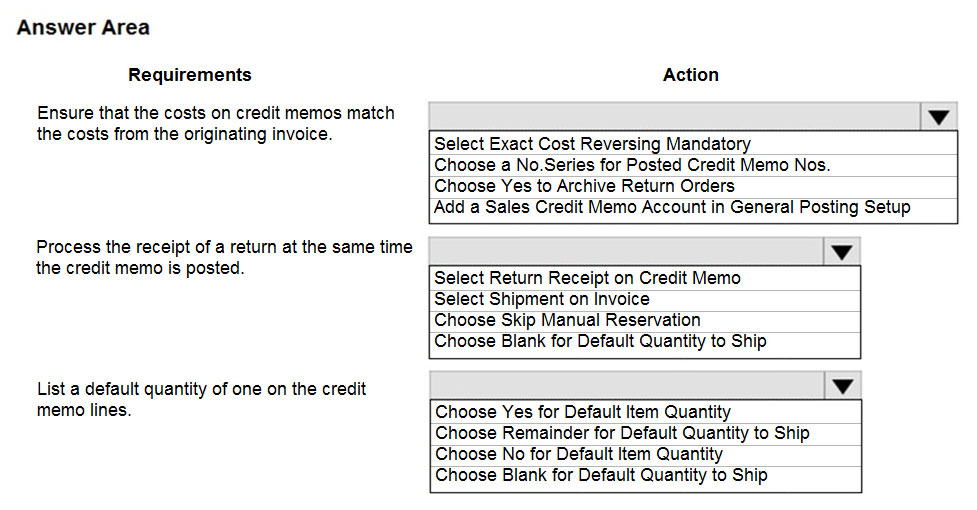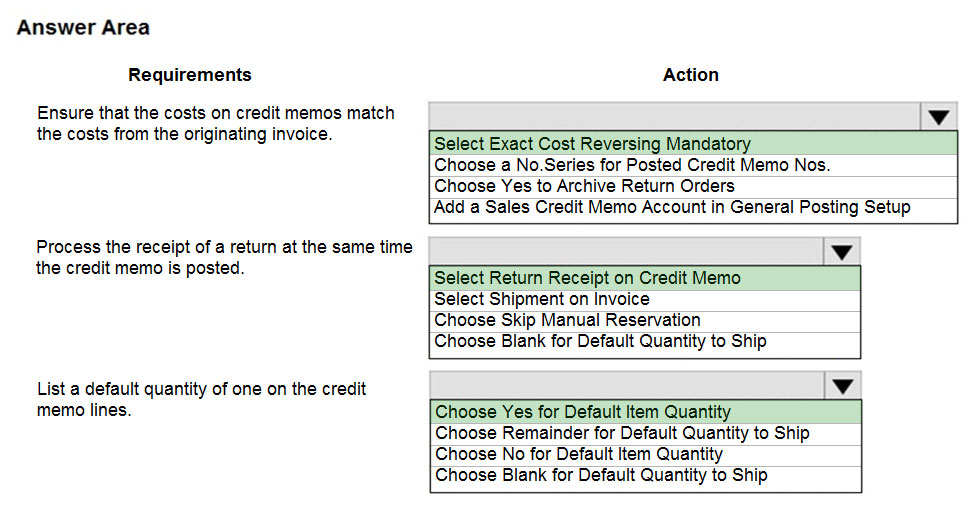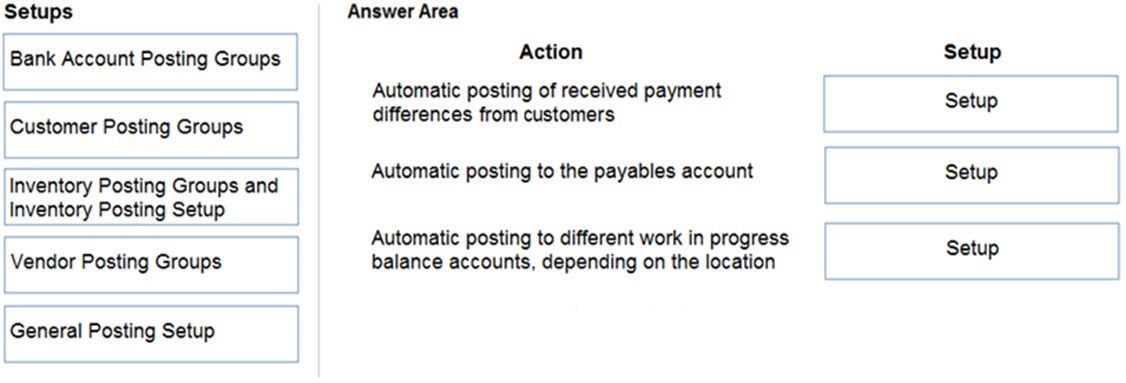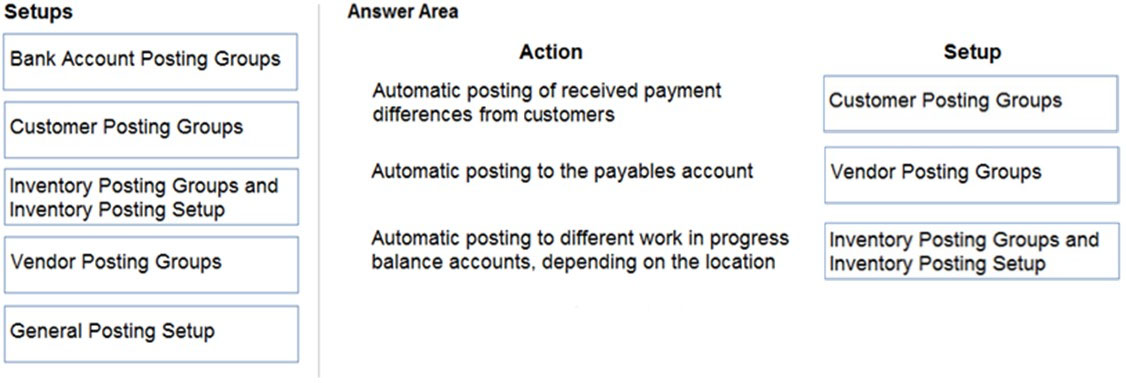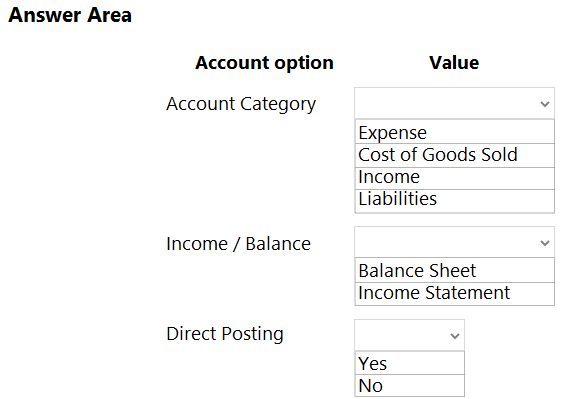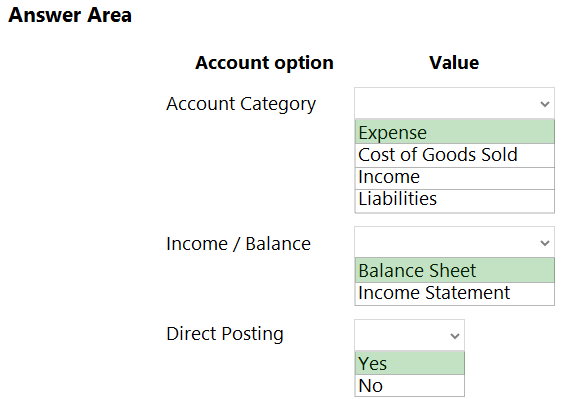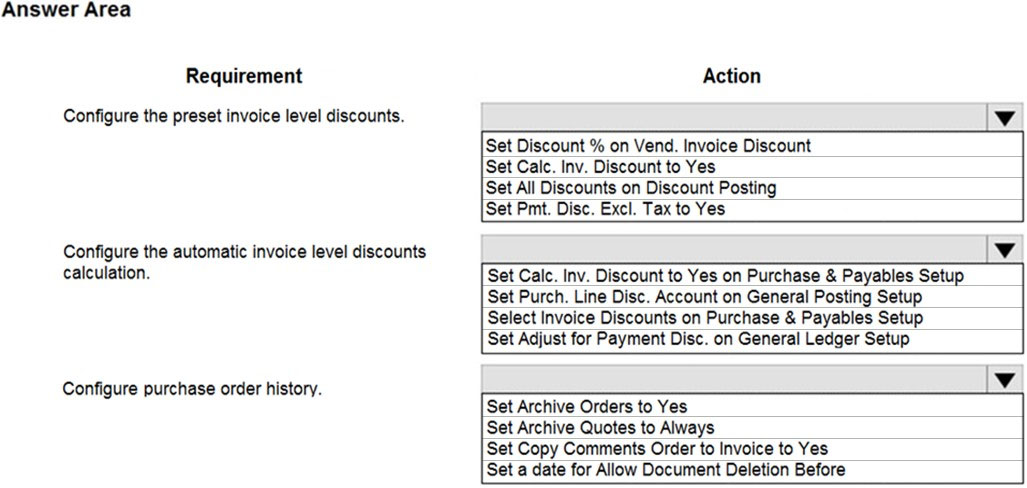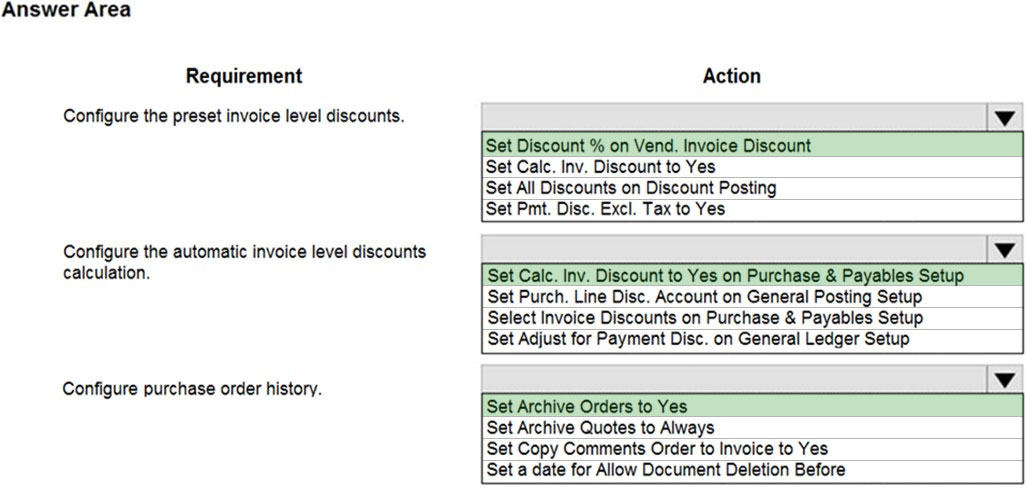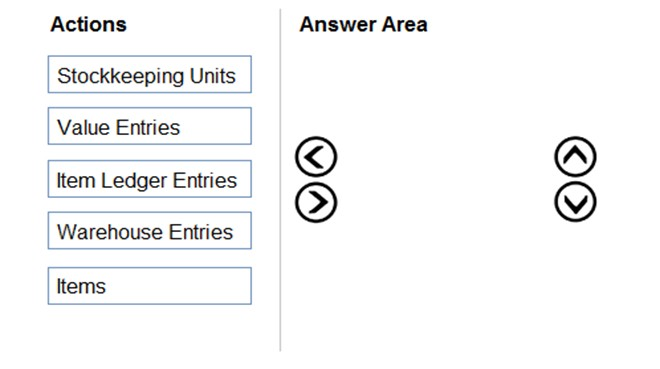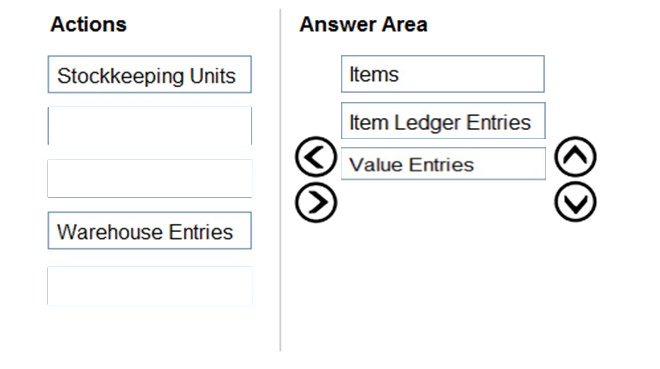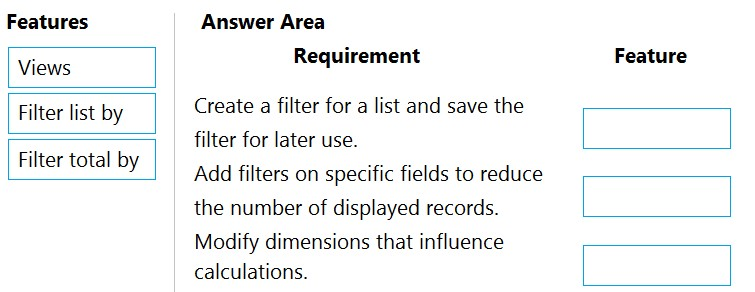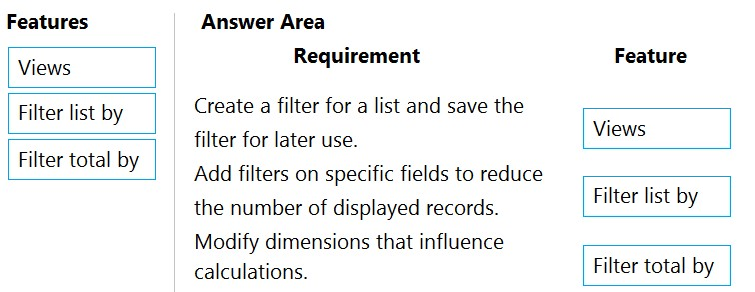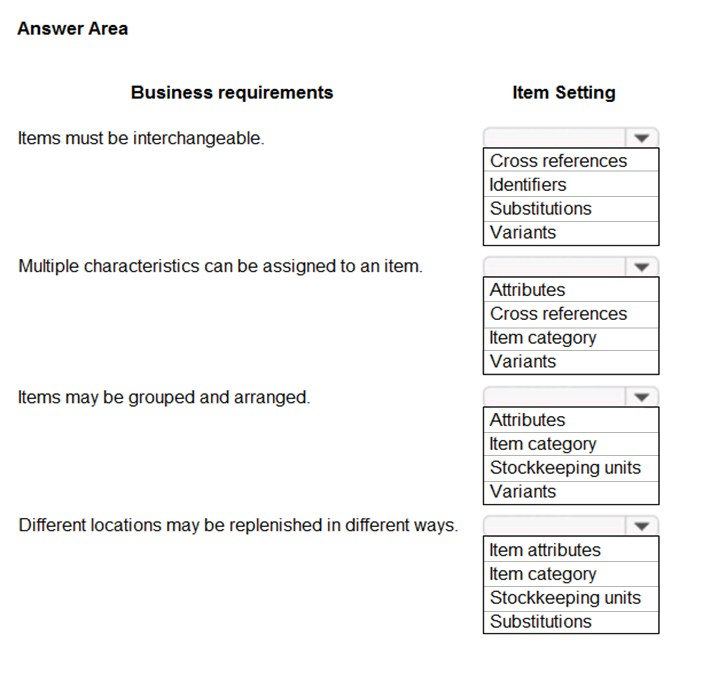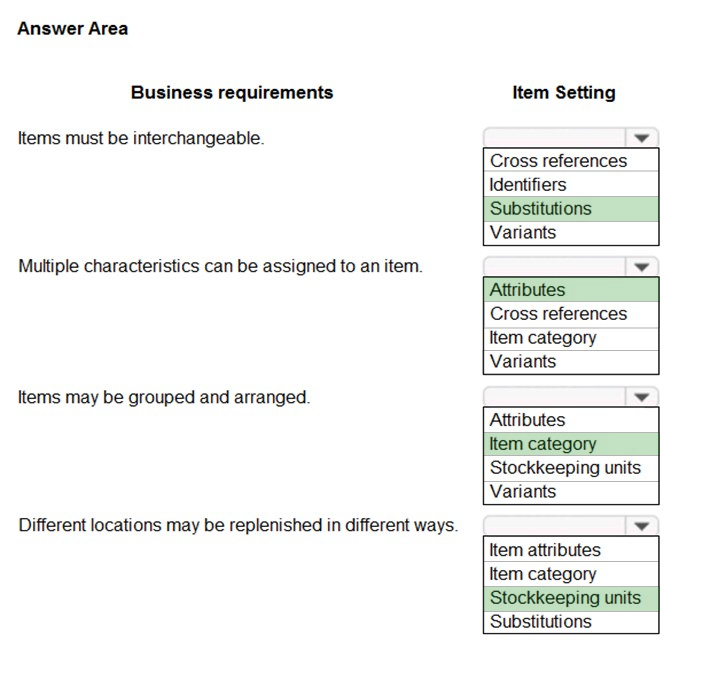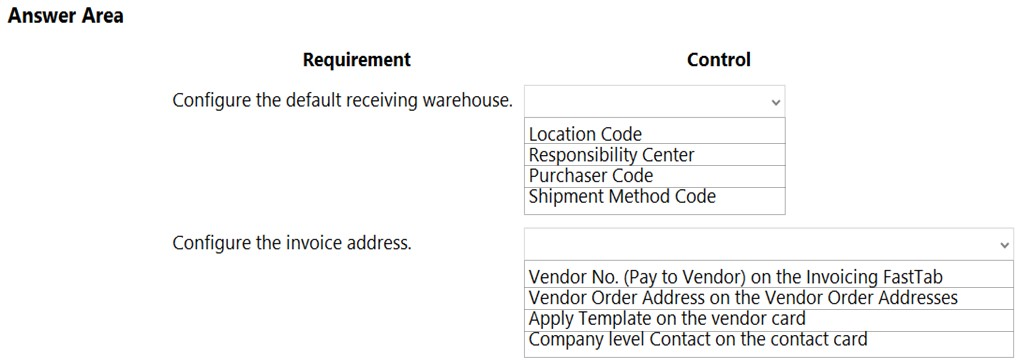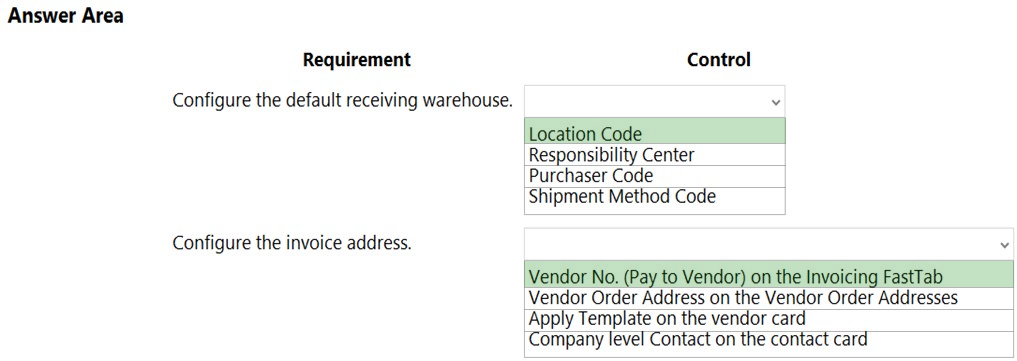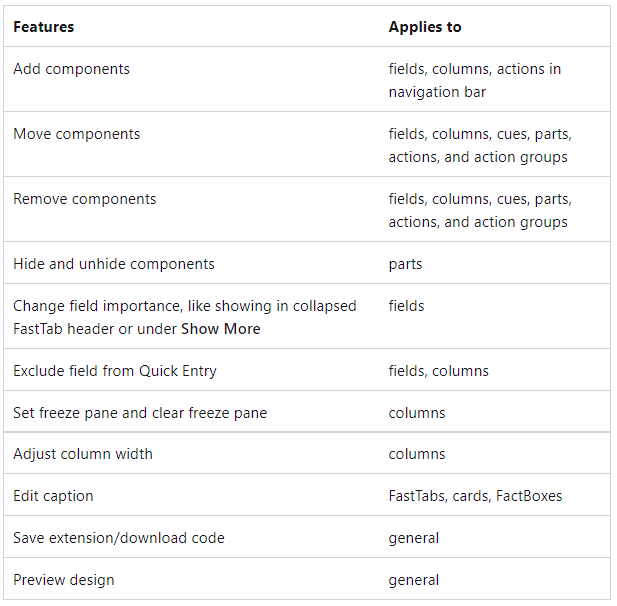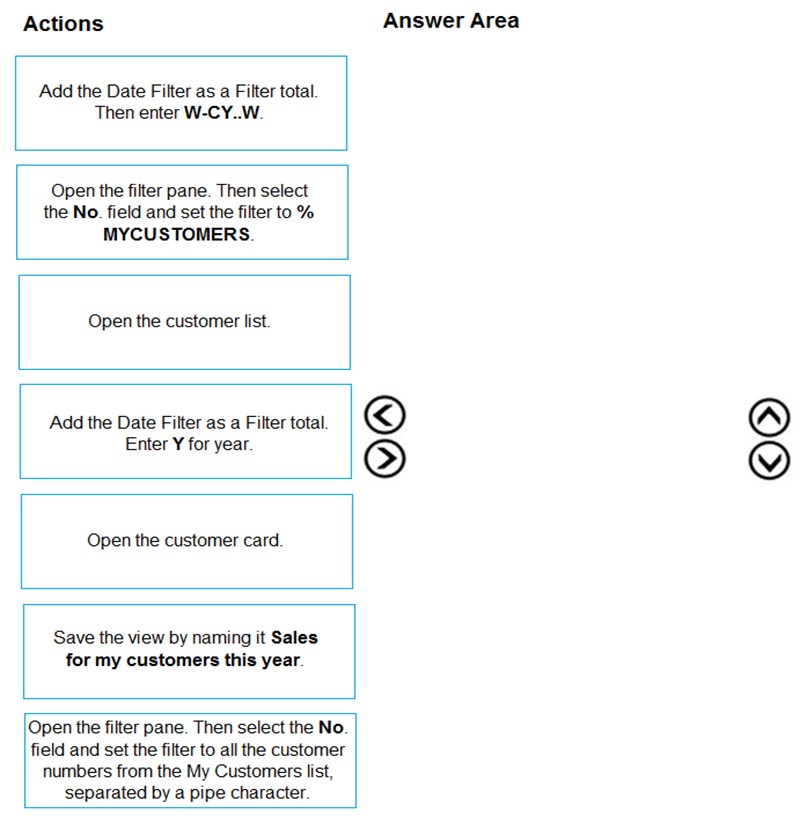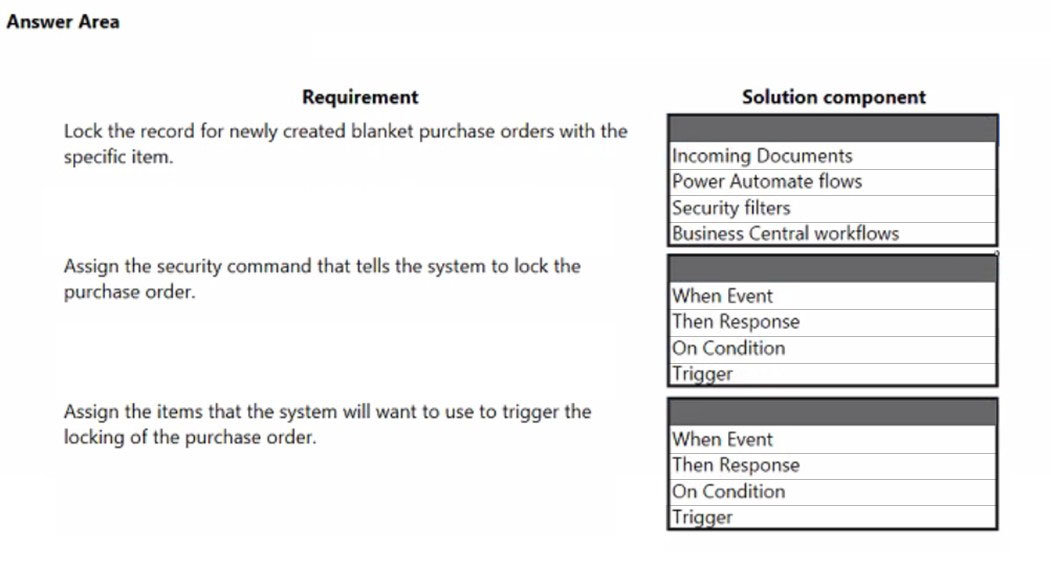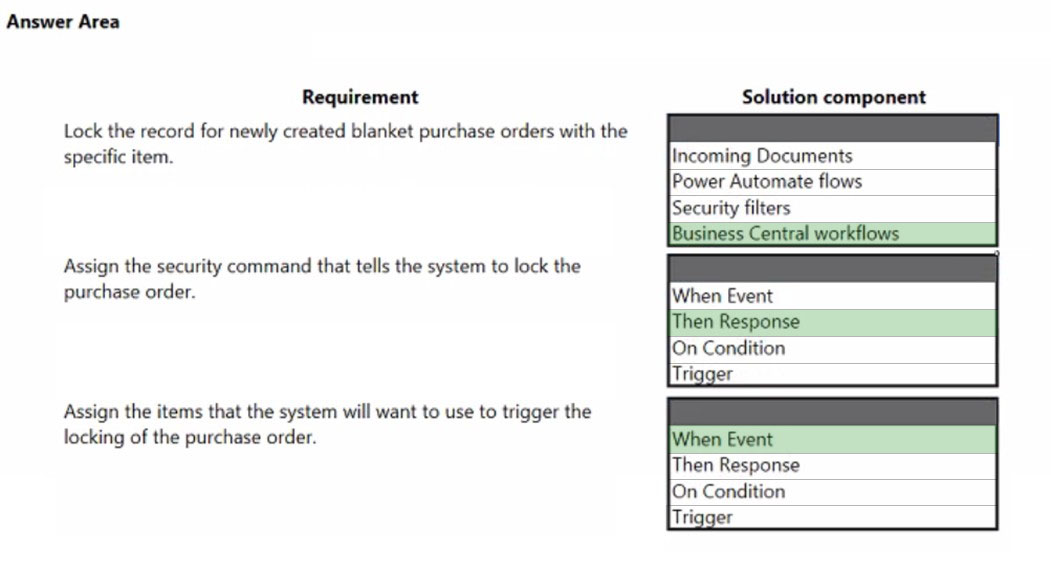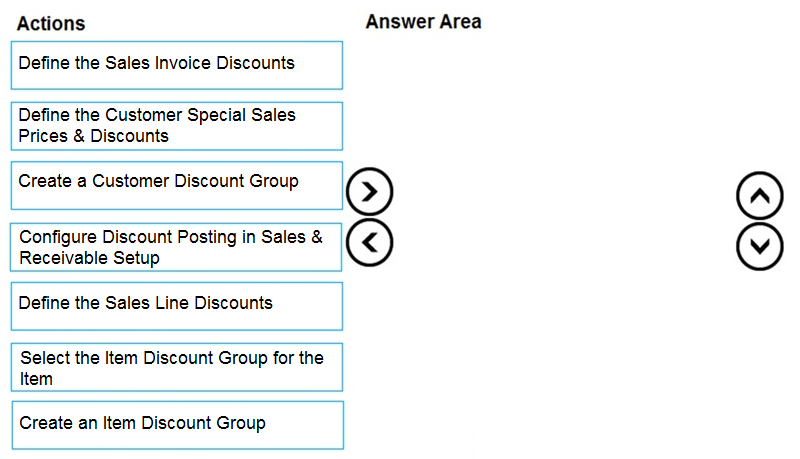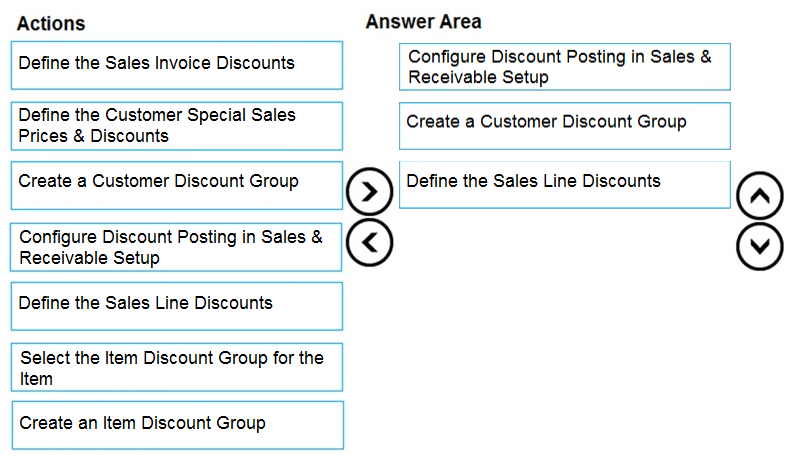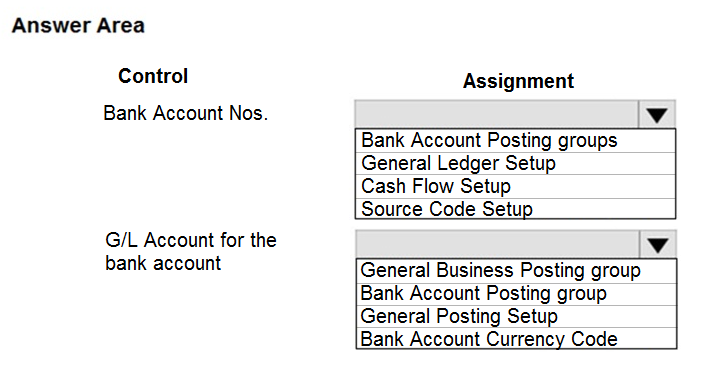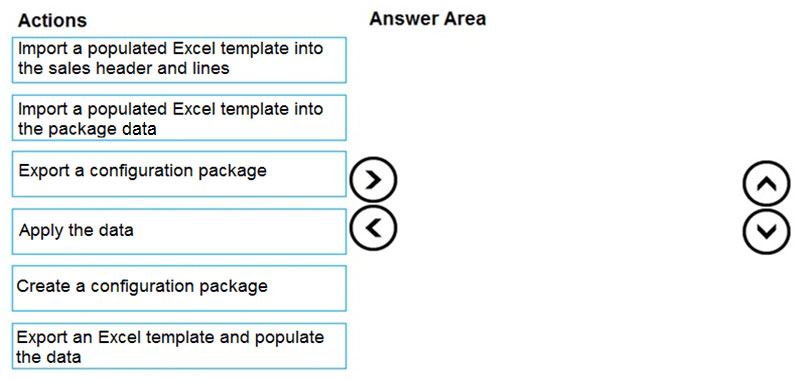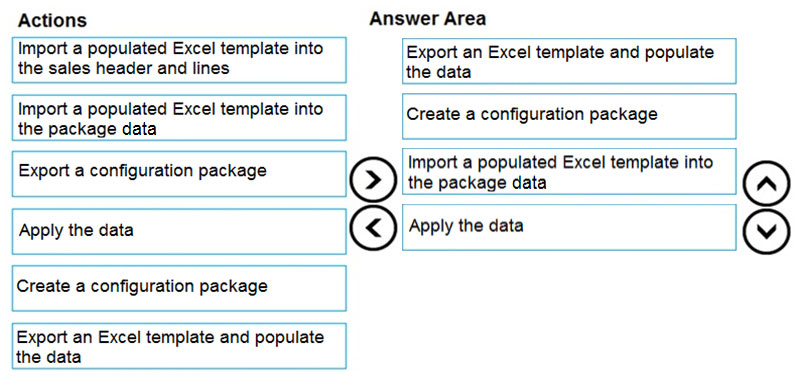MB-800 Mock Test Free – 50 Realistic Questions to Prepare with Confidence.
Getting ready for your MB-800 certification exam? Start your preparation the smart way with our MB-800 Mock Test Free – a carefully crafted set of 50 realistic, exam-style questions to help you practice effectively and boost your confidence.
Using a mock test free for MB-800 exam is one of the best ways to:
- Familiarize yourself with the actual exam format and question style
- Identify areas where you need more review
- Strengthen your time management and test-taking strategy
Below, you will find 50 free questions from our MB-800 Mock Test Free resource. These questions are structured to reflect the real exam’s difficulty and content areas, helping you assess your readiness accurately.
A company uses Dynamics 365 Business Central for their receivables. The company wants to mark any automatically matched payments to open invoices as not requiring a review if they match the highest degree of confidence that the two transactions are a match. You need to configure payment matching rules. Which three criteria should you configure? Each correct answer presents part of the solution. NOTE: Each correct selection is worth one point.
A. Statement amount
B. Account number
C. Related-party fields
D. Transaction date
E. Transaction text
A company plans to verify that purchase invoices use agreed-upon prices and discounts. The company is configuring settings on a vendor card. The company receives a validation error when creating a purchase order for the vendor. You need to find out which setting is causing the validation error. Which configuration option on the vendor card must you populate?
A. Order address
B. Location code
C. Vendor Template
D. Purchase Prices
E. Vendor Posting Group
DRAG DROP - A company uses Dynamics 365 Business Central. The sales department requires an approval process for new products. A sales order of more than $10,000 must be approved by the sales director. You need to set up a sales approval workflow. Which page should you use? To answer, drag the appropriate pages to the correct requirements. Each page may be used once, more than once, or not at all. You may need to drag the split bar between panes or scroll to view content. NOTE: Each correct selection is worth one point.
HOTSPOT - A company implements Dynamics 365 Business Central. You record the following vendor ledger entries for a vendor. You record dates by using the following format: month/date/year.The company takes advantage of any payment discounts. You use the Suggest Vendor Payments batch job in the Payment Journal to identify payments that must be made. You ensure that any available payment discounts will be automatically subtracted from the amount to be paid to the vendor. You need to ensure that the invoices and credit memos for the vendor are included in the results of the Suggest Vendor Payments batch job. Which report filters should you use? To answer, select the appropriate options in the answer area. NOTE: Each correct selection is worth one point. Hot Area:
A company uses Dynamics 365 Business Central. A customer requests that the company always use their preferred shipping provider for all sales orders. You need to configure the system to meet this requirement. What should you do?
A. Select Shipping Advice
B. Define a shipping agent
C. Set up a Ship-to code
D. Designate a Responsibility center
DRAG DROP - A company uses Dynamics 365 Business Central. The company's funds are limited and some invoices that are due cannot be paid on time. You need to prioritize vendors when you suggest vendor payments. Which three actions should you perform in sequence? To answer, move the appropriate actions from the list of actions to the answer area and arrange them in the correct order. Select and Place:
DRAG DROP - A company uses Dynamics 365 Business Central. You assign a purchasing profile to all users in the purchasing department. A user moves from the purchasing department to another department. You need to remove all personalizations in the user's profile. Which three actions should you perform in sequence? To answer, move the appropriate actions from the list of actions to the answer area and arrange them in the correct order. Select and Place:
You are creating payment terms. A company processes standard vendor payments on the seventh day of the next month. You need to set up payment terms for the vendor. Which date formula should you use?
A. 37D
B. 1M+7D
C. 1M+6D
D. CM+7D
After you answer a question in this section, you will NOT be able to return to it. As a result, these questions will not appear in the review screen. You must streamline monthly invoicing by automating repetitive entries for monthly charges when managing subscriptions. You need to add default general ledger (GL) accounts to a Customer Card. Solution: Configure a Standard Purchase Code Card and assign it to a Vendor Card. Does the solution meet the goal?
A. Yes
B. No
HOTSPOT - A company uses Dynamics 365 Business Central. The company wants to automate sales credit memo processing. You need to configure the system to meet the requirements. What should you do? To answer, select the appropriate options in the answer area. NOTE: Each correct selection is worth one point. Hot Area:
DRAG DROP - A company uses Dynamics 365 Business Central. You need to configure the system for new customers. Which features should you use? To answer, drag the appropriate features to the correct requirements. Each feature may be used once, more than once, or not at all. You may need to drag the split bar between panes or scroll to view content. NOTE: Each correct selection is worth one point. Select and Place:
DRAG DROP - You are implementing Dynamics 365 Business Central. The accounting manager of the company provides you with the chart of accounts. You need to set up specific posting groups according to the chart of accounts. Which setup should you use? To answer, drag the appropriate setup to the correct action. Each setup may be used once, more than once, or not at all. You may need to drag the split bar between panes or scroll to view content. NOTE: Each correct selection is worth one point. Select and Place:
You need to configure the system to meet the requirements for sending invoices. Which three actions should you perform? Each correct answer presents part of the solution. NOTE: Each correct selection is worth one point.
A. Set Email to Yes (Use Default Settings).
B. Allow Sender Substitution for SMTP Mail Setup.
C. Set Email to Yes (Prompt for Settings).
D. Assign a Document Sending Profile to the Customer where Email is set to No.
E. Apply Office Server Settings to the SMTP Mail Setup.
F. Assign a Document Sending Profile to the Customer where Email is set to Yes.
HOTSPOT - You are implementing Dynamics 365 Business Central. You are creating an expense account for office supplies in the chart of accounts. The account may be used for purchase invoice transactions as well as general journal transactions. You need to configure the remaining options for the account. Which values should you use? To answer, select the appropriate options in the answer area. NOTE: Each correct selection is worth one point. Hot Area:
Case study - This is a case study. Case studies are not timed separately. You can use as much exam time as you would like to complete each case. However, there may be additional case studies and sections on this exam. You must manage your time to ensure that you are able to complete all questions included on this exam in the time provided. To answer the questions included in a case study, you will need to reference information that is provided in the case study. Case studies might contain exhibits and other resources that provide more information about the scenario that is described in the case study. Each question is independent of the other questions in this case study. At the end of this case study, a review screen will appear. This screen allows you to review your answers and to make changes before you move to the next section of the exam. After you begin a new section, you cannot return to this section. To start the case study - To display the first question in this case study, click the Next button. Use the buttons in the left pane to explore the content of the case study before you answer the questions. Clicking these buttons displays information such as business requirements, existing environment, and problem statements. If the case study has an All Information tab, note that the information displayed is identical to the information displayed on the subsequent tabs. When you are ready to answer a question, click the Question button to return to the question. Background - Northwind Traders is an independent, family-owned business. The company distributes natural pet products in the Northwest region of the country/region. Products are purchased directly from manufacturers and distributed by using its own fleet of trucks. When the company started, deliveries were within a three-hour radius of the warehouse. Due to regional growth, current deliveries require drivers to stay overnight on some routes. The company plans to open a second warehouse to expand the region and eliminate overnights for route drivers. The company also plans to hire a second group of employees to run operations in this new location. The finance and accounting teams will remain in the original location. The company uses a third-party system for financials and order management. The finance department stated that the company’s fiscal year begins on July 1 and ends on June 30. The mm/dd/yyyy date format is used. As part of the expansion, the owner plans to upgrade to an ERP system and use Business Central to fulfill the company requirements and manage growth. Current environment - Orders - • Orders are emailed to customer service and manually keyed into the inventory system. Pricing and discounts - • Customer pricing is determined by the customer market type. Customer market types are Retail, Veterinarian, and Breeder. Each customer is associated with only one market type. • Vendors offer monthly promotions to customers by item, brand, or item category. • Invoices should show each customer’s base price, the discount amount, and the net price. Accounts payable - • The company wants to expand vendor payment options in the new system. Requirement - Customers - • The sales team must be able to do the following: o Quickly set up new customers with the proper settings based on customer type. o Identify customers by market type. Customer posting groups will be used to identify which market the customer belongs to. • Base price is determined by the customer market type. • The sales department should receive a warning when entering the order if a customer is over their credit limit. Sales - • Customer discounts are offered for specific time frames by item, brand, or product category. Discounts should be added to sales lines automatically. • Discounts must post to a unique general ledger (G/L) account. • The business needs to be able to track revenue by location, market, and product category dimensions. Locations 100 and 200 will be set as default dimensions on the two warehouse locations. Food, treats, toys, and supplies are the required product categories, which will be set as default dimensions on the item cards. Each customer card will have a default market dimension. • The sales manager wants to delete canceled orders and automatically archive them. Warehouse - • Orders will be fulfilled from two possible warehouse locations. • Product will be transferred between locations by using transfer orders. Sales invoices - • Invoices will be posted after delivery. • Invoices will be emailed to the customer. • The sales department must be able to quickly correct posted invoices for the following scenarios: o Posted invoices that have not been paid. o Posted invoices that have been paid. o Posted invoices created from sales orders. o Posted invoices not created from sales orders. Accounting - • The finance department requires that the company has 12 monthly accounting periods per fiscal year. • Finance department users must be able to reconcile the accounts receivable (AR) subledger to the G/L account at month end. • AR department users need the ability to settle and close invoices when customers take payment discounts after the payment discount date has passed. AR users should be allowed to accept or reject the payment tolerance. • Accounts payable (AP) department users must be able to pay vendors by electronic funds transfer (EFT) and use a payment journal batch named EFT to process payments. • When viewing G/L entries, the finance and accounting teams must be able to see debits and credits instead of a positive or negative amount. • The company needs to be able to track expenses by department and location. The departments are sales, operations, and administration. • AR must be able to correct cash application entries. Issues - Payment application - • Customers may have several stores that are responsible for their own orders and payments. • Occasionally, AR clerks mistakenly apply payments to the incorrect customer invoice. Invoicing - • When items are delivered, customers refuse the items for reasons such as damaged or wrong item. • After the invoices are posted, they must be corrected, which is time-consuming. Warehouse - • The sales department and warehouse managers must have visibility into products that are in the process of being transferred between locations. Accounts - • Customer accounts are difficult to view by market type. • The finance team does not have the ability to report revenue by customer type. Accounting - • AR users often find variances between the AR subledger and G/L account. • Customers often take the payment discount after the payment discount date has passed, leaving open invoices for small amounts. • The AP department is unable to pay vendors by EFT in the current system. • Finance and accounting team members have trouble validating postings when they use only the amounts field on G/L entries. • The finance department is unable to run financial reports by market. All revenue postings must reference a market. You need to configure payment discounts to resolve the issue reported by the AR users. Which two options should you configure? Each correct answer presents part of the solution. NOTE: Each correct selection is worth one point.
A. Sales & Receivables Setup
B. Payment Discount Grace Period
C. Payment Tolerance Warning
D. Pmt. Disc. Tolerance Warning
A customer in the restaurant buying group purchases olive oil on the date of the overstock special. You need to verify the sales price of the product for the customer. Which price will the system generate?
A. $15.30
B. $16.15
C. $17.00
D. $18.00
DRAG DROP - You are implementing Dynamics 365 Business Central. The purchasing manager wants to implement an approval system by using email notifications. You need to set up the notification system. Which setup should you use? To answer, drag the appropriate setup to the correct actions. Each setup may be used once, more than once, or not at all. You may need to drag the split bar between panes or scroll to view content. NOTE: Each correct selection is worth one point. Select and Place:
DRAG DROP - A company uses Dynamics 365 Business Central. A user creates two accounts for the same vendor. Both accounts have open vendor ledger entries. You need to merge any open entries from the second vendor account to the first vendor account and then delete the second vendor account. Which three actions should you perform in sequence? To answer, move the appropriate actions from the list of actions to the answer area and arrange them in the correct order.
HOTSPOT - You need to configure purchase order discounting and history. What should you do? To answer, select the appropriate options in the answer area. NOTE: Each correct selection is worth one point. Hot Area:
A company implements Dynamics 365 Business Central. You need to create a new payment terms record to meet the following requirements: ✑ Ensure that the due date for all vendor invoices is 30 days. ✑ Grant vendors a two percent discount if an invoice is paid within 10 days. Which three actions should you perform? Each correct answer presents a part of the solution NOTE: Each correct selection is worth one point.
A. Set the value of the Discount Date Calculation field to 2D.
B. Set the value of the Discount Date Calculation field to 10D.
C. Set the value of the Discount % field to 2.
D. Set the value of the Due Date Calculation field to 30D.
E. Set the value of the Discount % field to 10.
You are setting up and testing a workflow with approval hierarchy in Dynamics 365 Business Central. In Approval User Setup, you configure the following users:You create and enable an approval workflow. You configure the workflow to use the approver limit type Approver Chain. To test the workflow, User1 creates a purchase order for $1,100 and runs the Send Approval Request function. You need to identify the actions that occur when the workflow runs. Which set of actions occurs?
A. User4 will receive an approval request. Once approved, the purchase order is released.
B. User3 receives an approval request. Once User3 approves the request, the purchase order is released.
C. User2 will receive an approval request. Once User2 approves the request, User3 will receive an approval request. Once User2 and User3 approve the request, the purchase order is released.
D. User1 will receive an approval request. Once User1 approves the request, User2 must approve the request. Once User2 approves the request, User3 must approve the request. Once User3 approves the request, the purchase order is released.
E. User3 will receive an approval request. Once User3 approves the request, the request is routed to User4 for approval. Once User4 approves the request, the purchase order is released.
DRAG DROP - You are setting up a new company for a customer. The customer wants to understand the structure of the elements involved in inventory posting. You need to describe the relationship between elements in a basic inventory setup. What is the hierarchical order of the elements included in inventory posting beginning with the master data? To answer, move the appropriate three entities from the list of actions to the answer area and arrange them in the correct order. Select and Place:
You are implementing Dynamics 365 Business Central for a customer who has two warehouses. The customer requires the following: ✑ different item pricing and vendors set up for items in each warehouse ✑ transactions tied to a specific location You need to configure Business Central per the customer requirements. Which three entities should you configure? Each correct answer presents part of the solution. NOTE: Each correct selection is worth one point.
A. Inventory setup
B. Warehouse setup
C. Stockkeeping units
D. Item card
E. Locations
After you answer a question in this section, you will NOT be able to return to it. As a result, these questions will not appear in the review screen. You are configuring default reports and layouts in Dynamics 365 Business Central. You must add new data items to the report and change the layout associated with the default Purchase Order report. A developer creates and deploys a new report object that includes the new data items and layout. You need to configure Business Central to use the new report object as the system default when printing purchase orders. Solution: On the Custom Report Layouts page, select the new report object. Use the Update Layout function to force Business Central to use the current report design. Does the solution meet the goal?
A. Yes
B. No
A company uses Dynamics 365 Business Central. A purchaser receives a price list workbook from a vendor. You need to upload prices to the system. Which two types of price data can you load? Each correct answer presents part of the solution. NOTE: Each correct selection is worth one point.
A. Unit of Measure code
B. Item No.
C. Customer price group
D. Campaign
DRAG DROP - A company uses Dynamics 365 Business Central. You need to create filters for ledger entries. Which features should you use? To answer, drag the appropriate features to the correct requirements. Each feature may be used once, more than once, or not at all. You may need to drag the split bar between panes or scroll to view content. NOTE: Each correct selection is worth one point. Select and Place:
HOTSPOT - You create a new item in Microsoft Dynamics 365 Business Central. You need to configure item settings. Which item settings should you use? To answer, select the appropriate options in the answer area. NOTE: Each correct selection is worth one point. Hot Area:
HOTSPOT - A company uses Dynamics 365 Business Central. A vendor needs to use a default warehouse location and invoice a different vendor for a purchase order. You need to configure the system to meet the requirements. Which controls should you use? To answer, select the appropriate options in the answer area. NOTE: Each correct selection is worth one point. Hot Area:
Case study - This is a case study. Case studies are not timed separately. You can use as much exam time as you would like to complete each case. However, there may be additional case studies and sections on this exam. You must manage your time to ensure that you are able to complete all questions included on this exam in the time provided. To answer the questions included in a case study, you will need to reference information that is provided in the case study. Case studies might contain exhibits and other resources that provide more information about the scenario that is described in the case study. Each question is independent of the other questions in this case study. At the end of this case study, a review screen will appear. This screen allows you to review your answers and to make changes before you move to the next section of the exam. After you begin a new section, you cannot return to this section. To start the case study - To display the first question in this case study, click the Next button. Use the buttons in the left pane to explore the content of the case study before you answer the questions. Clicking these buttons displays information such as business requirements, existing environment, and problem statements. If the case study has an All Information tab, note that the information displayed is identical to the information displayed on the subsequent tabs. When you are ready to answer a question, click the Question button to return to the question. Background - Northwind Traders is an independent, family-owned business. The company distributes natural pet products in the Northwest region of the country/region. Products are purchased directly from manufacturers and distributed by using its own fleet of trucks. When the company started, deliveries were within a three-hour radius of the warehouse. Due to regional growth, current deliveries require drivers to stay overnight on some routes. The company plans to open a second warehouse to expand the region and eliminate overnights for route drivers. The company also plans to hire a second group of employees to run operations in this new location. The finance and accounting teams will remain in the original location. The company uses a third-party system for financials and order management. The finance department stated that the company’s fiscal year begins on July 1 and ends on June 30. The mm/dd/yyyy date format is used. As part of the expansion, the owner plans to upgrade to an ERP system and use Business Central to fulfill the company requirements and manage growth. Current environment - Orders - • Orders are emailed to customer service and manually keyed into the inventory system. Pricing and discounts - • Customer pricing is determined by the customer market type. Customer market types are Retail, Veterinarian, and Breeder. Each customer is associated with only one market type. • Vendors offer monthly promotions to customers by item, brand, or item category. • Invoices should show each customer’s base price, the discount amount, and the net price. Accounts payable - • The company wants to expand vendor payment options in the new system. Requirement - Customers - • The sales team must be able to do the following: o Quickly set up new customers with the proper settings based on customer type. o Identify customers by market type. Customer posting groups will be used to identify which market the customer belongs to. • Base price is determined by the customer market type. • The sales department should receive a warning when entering the order if a customer is over their credit limit. Sales - • Customer discounts are offered for specific time frames by item, brand, or product category. Discounts should be added to sales lines automatically. • Discounts must post to a unique general ledger (G/L) account. • The business needs to be able to track revenue by location, market, and product category dimensions. Locations 100 and 200 will be set as default dimensions on the two warehouse locations. Food, treats, toys, and supplies are the required product categories, which will be set as default dimensions on the item cards. Each customer card will have a default market dimension. • The sales manager wants to delete canceled orders and automatically archive them. Warehouse - • Orders will be fulfilled from two possible warehouse locations. • Product will be transferred between locations by using transfer orders. Sales invoices - • Invoices will be posted after delivery. • Invoices will be emailed to the customer. • The sales department must be able to quickly correct posted invoices for the following scenarios: o Posted invoices that have not been paid. o Posted invoices that have been paid. o Posted invoices created from sales orders. o Posted invoices not created from sales orders. Accounting - • The finance department requires that the company has 12 monthly accounting periods per fiscal year. • Finance department users must be able to reconcile the accounts receivable (AR) subledger to the G/L account at month end. • AR department users need the ability to settle and close invoices when customers take payment discounts after the payment discount date has passed. AR users should be allowed to accept or reject the payment tolerance. • Accounts payable (AP) department users must be able to pay vendors by electronic funds transfer (EFT) and use a payment journal batch named EFT to process payments. • When viewing G/L entries, the finance and accounting teams must be able to see debits and credits instead of a positive or negative amount. • The company needs to be able to track expenses by department and location. The departments are sales, operations, and administration. • AR must be able to correct cash application entries. Issues - Payment application - • Customers may have several stores that are responsible for their own orders and payments. • Occasionally, AR clerks mistakenly apply payments to the incorrect customer invoice. Invoicing - • When items are delivered, customers refuse the items for reasons such as damaged or wrong item. • After the invoices are posted, they must be corrected, which is time-consuming. Warehouse - • The sales department and warehouse managers must have visibility into products that are in the process of being transferred between locations. Accounts - • Customer accounts are difficult to view by market type. • The finance team does not have the ability to report revenue by customer type. Accounting - • AR users often find variances between the AR subledger and G/L account. • Customers often take the payment discount after the payment discount date has passed, leaving open invoices for small amounts. • The AP department is unable to pay vendors by EFT in the current system. • Finance and accounting team members have trouble validating postings when they use only the amounts field on G/L entries. • The finance department is unable to run financial reports by market. All revenue postings must reference a market. You need to resolve the issue reported by the AR users from the finance department. What should you do?
A. Switch Blocked on the Customer Card to Yes.
B. Switch Direct Posting on the G/L Account Card to No.
C. Switch Blocked on the G/L Account Card to Yes.
D. Switch Direct Posting on the G/L Account Card to Yes.
A company uses Dynamics 365 Business Central to manage receivables. You must import a series of payments from a bank account and automatically match the payments against similar ledger entries already entered in Business Central. You need to import and apply the payments to the ledger entries that are automatically matched by the system. Which form should you use?
A. Payment services
B. Payment Application Rules
C. Payment Reconciliation Journal
D. Payment Registration
DRAG DROP - A company is replacing their current solution with Dynamics 365 Business Central. During the user acceptance testing, you identify several gaps in the solution. You must add new functionality to the accounts receivable role center to allow order entry clerks to view the number of sales orders that they have created for the month to date. Clerks must be able to move the new role center element to another position on their interface. Accounts receivable clerks each have a specific order in which they enter sales order data. You must optimize the order entry process for these users. You need to configure the system. Which features should you use? To answer, drag the appropriate features to the correct requirements. Each feature may be used once, more than once, or not at all. You may need to drag the split bar between panes or scroll to view content. NOTE: Each correct selection is worth one point. Select and Place:
DRAG DROP - Case study - This is a case study. Case studies are not timed separately. You can use as much exam time as you would like to complete each case. However, there may be additional case studies and sections on this exam. You must manage your time to ensure that you are able to complete all questions included on this exam in the time provided. To answer the questions included in a case study, you will need to reference information that is provided in the case study. Case studies might contain exhibits and other resources that provide more information about the scenario that is described in the case study. Each question is independent of the other questions in this case study. At the end of this case study, a review screen will appear. This screen allows you to review your answers and to make changes before you move to the next section of the exam. After you begin a new section, you cannot return to this section. To start the case study - To display the first question in this case study, click the Next button. Use the buttons in the left pane to explore the content of the case study before you answer the questions. Clicking these buttons displays information such as business requirements, existing environment, and problem statements. If the case study has an All Information tab, note that the information displayed is identical to the information displayed on the subsequent tabs. When you are ready to answer a question, click the Question button to return to the question. Background - Northwind Traders is an independent, family-owned business. The company distributes natural pet products in the Northwest region of the country/region. Products are purchased directly from manufacturers and distributed by using its own fleet of trucks. When the company started, deliveries were within a three-hour radius of the warehouse. Due to regional growth, current deliveries require drivers to stay overnight on some routes. The company plans to open a second warehouse to expand the region and eliminate overnights for route drivers. The company also plans to hire a second group of employees to run operations in this new location. The finance and accounting teams will remain in the original location. The company uses a third-party system for financials and order management. The finance department stated that the company’s fiscal year begins on July 1 and ends on June 30. The mm/dd/yyyy date format is used. As part of the expansion, the owner plans to upgrade to an ERP system and use Business Central to fulfill the company requirements and manage growth. Current environment - Orders - • Orders are emailed to customer service and manually keyed into the inventory system. Pricing and discounts - • Customer pricing is determined by the customer market type. Customer market types are Retail, Veterinarian, and Breeder. Each customer is associated with only one market type. • Vendors offer monthly promotions to customers by item, brand, or item category. • Invoices should show each customer’s base price, the discount amount, and the net price. Accounts payable - • The company wants to expand vendor payment options in the new system. Requirement - Customers - • The sales team must be able to do the following: o Quickly set up new customers with the proper settings based on customer type. o Identify customers by market type. Customer posting groups will be used to identify which market the customer belongs to. • Base price is determined by the customer market type. • The sales department should receive a warning when entering the order if a customer is over their credit limit. Sales - • Customer discounts are offered for specific time frames by item, brand, or product category. Discounts should be added to sales lines automatically. • Discounts must post to a unique general ledger (G/L) account. • The business needs to be able to track revenue by location, market, and product category dimensions. Locations 100 and 200 will be set as default dimensions on the two warehouse locations. Food, treats, toys, and supplies are the required product categories, which will be set as default dimensions on the item cards. Each customer card will have a default market dimension. • The sales manager wants to delete canceled orders and automatically archive them. Warehouse - • Orders will be fulfilled from two possible warehouse locations. • Product will be transferred between locations by using transfer orders. Sales invoices - • Invoices will be posted after delivery. • Invoices will be emailed to the customer. • The sales department must be able to quickly correct posted invoices for the following scenarios: o Posted invoices that have not been paid. o Posted invoices that have been paid. o Posted invoices created from sales orders. o Posted invoices not created from sales orders. Accounting - • The finance department requires that the company has 12 monthly accounting periods per fiscal year. • Finance department users must be able to reconcile the accounts receivable (AR) subledger to the G/L account at month end. • AR department users need the ability to settle and close invoices when customers take payment discounts after the payment discount date has passed. AR users should be allowed to accept or reject the payment tolerance. • Accounts payable (AP) department users must be able to pay vendors by electronic funds transfer (EFT) and use a payment journal batch named EFT to process payments. • When viewing G/L entries, the finance and accounting teams must be able to see debits and credits instead of a positive or negative amount. • The company needs to be able to track expenses by department and location. The departments are sales, operations, and administration. • AR must be able to correct cash application entries. Issues - Payment application - • Customers may have several stores that are responsible for their own orders and payments. • Occasionally, AR clerks mistakenly apply payments to the incorrect customer invoice. Invoicing - • When items are delivered, customers refuse the items for reasons such as damaged or wrong item. • After the invoices are posted, they must be corrected, which is time-consuming. Warehouse - • The sales department and warehouse managers must have visibility into products that are in the process of being transferred between locations. Accounts - • Customer accounts are difficult to view by market type. • The finance team does not have the ability to report revenue by customer type. Accounting - • AR users often find variances between the AR subledger and G/L account. • Customers often take the payment discount after the payment discount date has passed, leaving open invoices for small amounts. • The AP department is unable to pay vendors by EFT in the current system. • Finance and accounting team members have trouble validating postings when they use only the amounts field on G/L entries. • The finance department is unable to run financial reports by market. All revenue postings must reference a market. You need to train the sales department how to correct posted sales invoices. Which action should you use for each scenario? To answer, drag the appropriate actions to the correct scenarios. Each action may be used once, more than once, or not at all. You may need to drag the split bar between panes or scroll to view content. NOTE: Each correct selection is worth one point.
You are setting up a new company for a customer. The customer wants to sell items in D, but refer to the items as pieces. Each box contains 12 pieces. Each pallet contains 144 pieces. You need to assign the unit of measures to items. How should you assign the unit of measures?
A. Create Box as a base unit of measure. Add Pieces as an item unit of measure with the quantity per unit set to 0.08333.
B. Create Pieces as an item unit of measure with a quantity per unit of measure set to 1.
C. Create Pieces as a base unit of measure. Add Box as an item unit of measure with the quantity per unit set to 12.
D. Create Pallet as a base unit of measure. Add Pallet as an item unit of measure with the quantity per unit set to 12.
HOTSPOT - Case study - This is a case study. Case studies are not timed separately. You can use as much exam time as you would like to complete each case. However, there may be additional case studies and sections on this exam. You must manage your time to ensure that you are able to complete all questions included on this exam in the time provided. To answer the questions included in a case study, you will need to reference information that is provided in the case study. Case studies might contain exhibits and other resources that provide more information about the scenario that is described in the case study. Each question is independent of the other questions in this case study. At the end of this case study, a review screen will appear. This screen allows you to review your answers and to make changes before you move to the next section of the exam. After you begin a new section, you cannot return to this section. To start the case study - To display the first question in this case study, click the Next button. Use the buttons in the left pane to explore the content of the case study before you answer the questions. Clicking these buttons displays information such as business requirements, existing environment, and problem statements. If the case study has an All Information tab, note that the information displayed is identical to the information displayed on the subsequent tabs. When you are ready to answer a question, click the Question button to return to the question. Background - Northwind Traders is an independent, family-owned business. The company distributes natural pet products in the Northwest region of the country/region. Products are purchased directly from manufacturers and distributed by using its own fleet of trucks. When the company started, deliveries were within a three-hour radius of the warehouse. Due to regional growth, current deliveries require drivers to stay overnight on some routes. The company plans to open a second warehouse to expand the region and eliminate overnights for route drivers. The company also plans to hire a second group of employees to run operations in this new location. The finance and accounting teams will remain in the original location. The company uses a third-party system for financials and order management. The finance department stated that the company’s fiscal year begins on July 1 and ends on June 30. The mm/dd/yyyy date format is used. As part of the expansion, the owner plans to upgrade to an ERP system and use Business Central to fulfill the company requirements and manage growth. Current environment - Orders - • Orders are emailed to customer service and manually keyed into the inventory system. Pricing and discounts - • Customer pricing is determined by the customer market type. Customer market types are Retail, Veterinarian, and Breeder. Each customer is associated with only one market type. • Vendors offer monthly promotions to customers by item, brand, or item category. • Invoices should show each customer’s base price, the discount amount, and the net price. Accounts payable - • The company wants to expand vendor payment options in the new system. Requirement - Customers - • The sales team must be able to do the following: o Quickly set up new customers with the proper settings based on customer type. o Identify customers by market type. Customer posting groups will be used to identify which market the customer belongs to. • Base price is determined by the customer market type. • The sales department should receive a warning when entering the order if a customer is over their credit limit. Sales - • Customer discounts are offered for specific time frames by item, brand, or product category. Discounts should be added to sales lines automatically. • Discounts must post to a unique general ledger (G/L) account. • The business needs to be able to track revenue by location, market, and product category dimensions. Locations 100 and 200 will be set as default dimensions on the two warehouse locations. Food, treats, toys, and supplies are the required product categories, which will be set as default dimensions on the item cards. Each customer card will have a default market dimension. • The sales manager wants to delete canceled orders and automatically archive them. Warehouse - • Orders will be fulfilled from two possible warehouse locations. • Product will be transferred between locations by using transfer orders. Sales invoices - • Invoices will be posted after delivery. • Invoices will be emailed to the customer. • The sales department must be able to quickly correct posted invoices for the following scenarios: o Posted invoices that have not been paid. o Posted invoices that have been paid. o Posted invoices created from sales orders. o Posted invoices not created from sales orders. Accounting - • The finance department requires that the company has 12 monthly accounting periods per fiscal year. • Finance department users must be able to reconcile the accounts receivable (AR) subledger to the G/L account at month end. • AR department users need the ability to settle and close invoices when customers take payment discounts after the payment discount date has passed. AR users should be allowed to accept or reject the payment tolerance. • Accounts payable (AP) department users must be able to pay vendors by electronic funds transfer (EFT) and use a payment journal batch named EFT to process payments. • When viewing G/L entries, the finance and accounting teams must be able to see debits and credits instead of a positive or negative amount. • The company needs to be able to track expenses by department and location. The departments are sales, operations, and administration. • AR must be able to correct cash application entries. Issues - Payment application - • Customers may have several stores that are responsible for their own orders and payments. • Occasionally, AR clerks mistakenly apply payments to the incorrect customer invoice. Invoicing - • When items are delivered, customers refuse the items for reasons such as damaged or wrong item. • After the invoices are posted, they must be corrected, which is time-consuming. Warehouse - • The sales department and warehouse managers must have visibility into products that are in the process of being transferred between locations. Accounts - • Customer accounts are difficult to view by market type. • The finance team does not have the ability to report revenue by customer type. Accounting - • AR users often find variances between the AR subledger and G/L account. • Customers often take the payment discount after the payment discount date has passed, leaving open invoices for small amounts. • The AP department is unable to pay vendors by EFT in the current system. • Finance and accounting team members have trouble validating postings when they use only the amounts field on G/L entries. • The finance department is unable to run financial reports by market. All revenue postings must reference a market. You need to create accounting periods based on the requirements from the finance department. Which values should you use for each configuration? To answer, select the appropriate option in the answer area. NOTE: Each correct selection is worth one point.
DRAG DROP - A company uses Dynamics 365 Business Central. The company bills thousands of sales invoices for recurring subscription services on a monthly basis. You need to ensure recurring sales invoices are automatically created for the same subscription services. Which four actions should you perform in sequence? To answer, move the appropriate actions from the list of actions to the answer area and arrange them in the correct order.
DRAG DROP - A client uses Dynamics 365 Business Central. The client must create a manufacturing company and a sales company in Business Central. Each company must be a separate legal entity. The client must select a costing method to use. You need to explain the effects of the different costing methods. What should you describe for each costing method? To answer, move the appropriate effect to the correct costing method. You may use each effect once, more than once, or not at all. You may need to drag the split bar between panes or scroll to view content. NOTE: Each correct selection is worth one point.
DRAG DROP - You are setting up a new company for a customer. The customer wants you to filter the view to show all customers in the My Customers list and calculate the year-to-date sales. You need to apply the filter. Which four actions should you perform in sequence? To answer, move the appropriate entities from the list of actions to the answer area and arrange them in the correct order. NOTE: More than one order of answer choices is correct. You will receive credit for any of the correct orders you select. Select and Place:
HOTSPOT - A company creates blanket purchase orders from inbound documents that are sent to Dynamics 365 Business Central by purchasing agents. When a new blanket purchase order is created with a certain item, the system must send a procurement supervisor a request to approve the purchase order. Purchase orders must not be posted until the procurement supervisor approves the purchase order. You need to configure the system. To answer, select the appropriate options in the answer area NOTE: Each correct selection is worth one point. Hot Area:
DRAG DROP - You need to configure discounting for sales. Which three actions should you perform in sequence? To answer, move the appropriate actions from the list of actions to the answer area. Select and Place:
A company has been using Dynamics 365 Business Central for many years. A new accounting manager for the company reviews the chart of accounts. The manager wants to remove some general ledger accounts. The Check G/L Account Usage field is selected in the General Ledger Setup. You need to assist with the account deletions. What is one requirement that enables deletion of a general ledger account?
A. The account cannot be used in any posting groups or posting setup.
B. The general ledger account is configured to allow for deletion.
C. The general ledger account cannot allow for direct posting.
D. The general ledger account must be of the type Balance Sheet.
DRAG DROP - You set up a sales module for a company. The manager provides you with the company sales price list. The correct net price for products must display when the sales team creates sales orders. You need to configure the system. Which setup types should you use? To answer, drag the appropriate setup types to the correct scenarios. Each setup type may be used once, more than once, or not at all. You may need to drag the split bar between panes or scroll to view content. NOTE: Each correct selection is worth one point. Select and Place:
A company records vendor-wise item descriptions. You need to set up vendor-specific descriptions for items. What should you set up?
A. Item variants
B. Substitutions
C. Item cross-references
D. Extended text
HOTSPOT - A bank is implementing Dynamics 365 Business Central. Each bank account must be configured to a unique G/L Account. You need to set up the first bank account. How should you configure the system? To answer, select the appropriate options in the answer area. NOTE: Each correct selection is worth one point. Hot Area:
DRAG DROP - A company uses Dynamics 365 Business Central. Users in the purchasing and accounts payable departments require the following information about vendors and vendor ledger entries: • Balance (LCY) for vendor • Remaining amount for ledger entry • Amount for application entry You need to retrieve the vendor and vendor ledger entry information. Where should you navigate to find the information? To answer, drag the appropriate locations to the correct requirements. Each location may be used once, more than once, or not at all. You may need to drag the split bar between panes or scroll to view content. NOTE: Each correct selection is worth one point.
After you answer a question in this section, you will NOT be able to return to it. As a result, these questions will not appear in the review screen. You are configuring default reports and layouts in Dynamics 365 Business Central. You must add new data items to the report and change the layout associated with the default Purchase Order report. A developer creates and deploys a new report object that includes the new data items and layout. You need to configure Business Central to use the new report object as the system default when printing purchase orders. Solution: On the Report Selection `" Service page, set the value of the Usage option to Order. Update the Report ID shown on the page to reflect the new report object. Does the solution meet the goal?
A. Yes
B. No
Case study - This is a case study. Case studies are not timed separately. You can use as much exam time as you would like to complete each case. However, there may be additional case studies and sections on this exam. You must manage your time to ensure that you are able to complete all questions included on this exam in the time provided. To answer the questions included in a case study, you will need to reference information that is provided in the case study. Case studies might contain exhibits and other resources that provide more information about the scenario that is described in the case study. Each question is independent of the other questions in this case study. At the end of this case study, a review screen will appear. This screen allows you to review your answers and to make changes before you move to the next section of the exam. After you begin a new section, you cannot return to this section. To start the case study - To display the first question in this case study, click the Next button. Use the buttons in the left pane to explore the content of the case study before you answer the questions. Clicking these buttons displays information such as business requirements, existing environment, and problem statements. If the case study has an All Information tab, note that the information displayed is identical to the information displayed on the subsequent tabs. When you are ready to answer a question, click the Question button to return to the question. Background - Northwind Traders is an independent, family-owned business. The company distributes natural pet products in the Northwest region of the country/region. Products are purchased directly from manufacturers and distributed by using its own fleet of trucks. When the company started, deliveries were within a three-hour radius of the warehouse. Due to regional growth, current deliveries require drivers to stay overnight on some routes. The company plans to open a second warehouse to expand the region and eliminate overnights for route drivers. The company also plans to hire a second group of employees to run operations in this new location. The finance and accounting teams will remain in the original location. The company uses a third-party system for financials and order management. The finance department stated that the company’s fiscal year begins on July 1 and ends on June 30. The mm/dd/yyyy date format is used. As part of the expansion, the owner plans to upgrade to an ERP system and use Business Central to fulfill the company requirements and manage growth. Current environment - Orders - • Orders are emailed to customer service and manually keyed into the inventory system. Pricing and discounts - • Customer pricing is determined by the customer market type. Customer market types are Retail, Veterinarian, and Breeder. Each customer is associated with only one market type. • Vendors offer monthly promotions to customers by item, brand, or item category. • Invoices should show each customer’s base price, the discount amount, and the net price. Accounts payable - • The company wants to expand vendor payment options in the new system. Requirement - Customers - • The sales team must be able to do the following: o Quickly set up new customers with the proper settings based on customer type. o Identify customers by market type. Customer posting groups will be used to identify which market the customer belongs to. • Base price is determined by the customer market type. • The sales department should receive a warning when entering the order if a customer is over their credit limit. Sales - • Customer discounts are offered for specific time frames by item, brand, or product category. Discounts should be added to sales lines automatically. • Discounts must post to a unique general ledger (G/L) account. • The business needs to be able to track revenue by location, market, and product category dimensions. Locations 100 and 200 will be set as default dimensions on the two warehouse locations. Food, treats, toys, and supplies are the required product categories, which will be set as default dimensions on the item cards. Each customer card will have a default market dimension. • The sales manager wants to delete canceled orders and automatically archive them. Warehouse - • Orders will be fulfilled from two possible warehouse locations. • Product will be transferred between locations by using transfer orders. Sales invoices - • Invoices will be posted after delivery. • Invoices will be emailed to the customer. • The sales department must be able to quickly correct posted invoices for the following scenarios: o Posted invoices that have not been paid. o Posted invoices that have been paid. o Posted invoices created from sales orders. o Posted invoices not created from sales orders. Accounting - • The finance department requires that the company has 12 monthly accounting periods per fiscal year. • Finance department users must be able to reconcile the accounts receivable (AR) subledger to the G/L account at month end. • AR department users need the ability to settle and close invoices when customers take payment discounts after the payment discount date has passed. AR users should be allowed to accept or reject the payment tolerance. • Accounts payable (AP) department users must be able to pay vendors by electronic funds transfer (EFT) and use a payment journal batch named EFT to process payments. • When viewing G/L entries, the finance and accounting teams must be able to see debits and credits instead of a positive or negative amount. • The company needs to be able to track expenses by department and location. The departments are sales, operations, and administration. • AR must be able to correct cash application entries. Issues - Payment application - • Customers may have several stores that are responsible for their own orders and payments. • Occasionally, AR clerks mistakenly apply payments to the incorrect customer invoice. Invoicing - • When items are delivered, customers refuse the items for reasons such as damaged or wrong item. • After the invoices are posted, they must be corrected, which is time-consuming. Warehouse - • The sales department and warehouse managers must have visibility into products that are in the process of being transferred between locations. Accounts - • Customer accounts are difficult to view by market type. • The finance team does not have the ability to report revenue by customer type. Accounting - • AR users often find variances between the AR subledger and G/L account. • Customers often take the payment discount after the payment discount date has passed, leaving open invoices for small amounts. • The AP department is unable to pay vendors by EFT in the current system. • Finance and accounting team members have trouble validating postings when they use only the amounts field on G/L entries. • The finance department is unable to run financial reports by market. All revenue postings must reference a market. You need to set up customer sales pricing based on the requirements. Which three actions should you perform? Each correct answer presents part of the solution. NOTE: Each correct selection is worth one point.
A. Create a Sales Price List for the customer by using the customer assign-to type.
B. Create a Sales Price List by using the assign-to type of Customer Price Group.
C. Create Customer Price Groups that allow line discounts.
D. Assign the Customer Price Group code on the customer card.
E. Create Customer Price Groups that exclude line discounts.
DRAG DROP - A manufacturer uses Dynamics 365 Business Central. The company has the following item types: • Raw Materials • Work-in-progress (WIP) • Finished Goods Different prefixes are used for item numbers to identify these item types. The company requires the following system setup: • Use a unique number series for each item type. • No. Series must be selectable when creating manual items. • Implement automatic number assignment. You need to configure the system. In which order should you perform the actions? To answer, move all actions from the list of actions to the answer area and arrange them in the correct order. NOTE: More than one order of answer choices is correct. You will receive credit for any of the correct orders you select.
DRAG DROP - You set up a new company for a customer. The customer provides you with a Microsoft Excel file that contains master data. You need to import the master data by using configuration packages. Which four actions should you perform in sequence? To answer, move the appropriate actions from the list of actions to the answer area and arrange them in the correct order. Select and Place:
DRAG DROP - A company implements Dynamics 365 Business Central. The company must import the following opening balances into Dynamics 365 Business Central: • Item • Bank • Customer You need to implement tools to import opening balances. Which components should you use? To answer, drag the appropriate components to the correct opening balances. Each component may be used once, more than once, or not at all. You may need to drag the split bar between panes or scroll to view content. NOTE: Each correct selection is worth one point.
After you answer a question in this section, you will NOT be able to return to it. As a result, these questions will not appear in the review screen. You are configuring default reports and layouts in Dynamics 365 Business Central. You must add new data items to the report and change the layout associated with the default Purchase Order report. A developer creates and deploys a new report object that includes the new data items and layout. You need to configure Business Central to use the new report object as the system default when printing purchase orders. Solution: On the Report Selection `" Purchase page, set the value of the Usage option to Order. Update the Report ID shown on the page to reflect the new report object. Does the solution meet the goal?
A. Yes
B. No
Access Full MB-800 Mock Test Free
Want a full-length mock test experience? Click here to unlock the complete MB-800 Mock Test Free set and get access to hundreds of additional practice questions covering all key topics.
We regularly update our question sets to stay aligned with the latest exam objectives—so check back often for fresh content!
Start practicing with our MB-800 mock test free today—and take a major step toward exam success!




